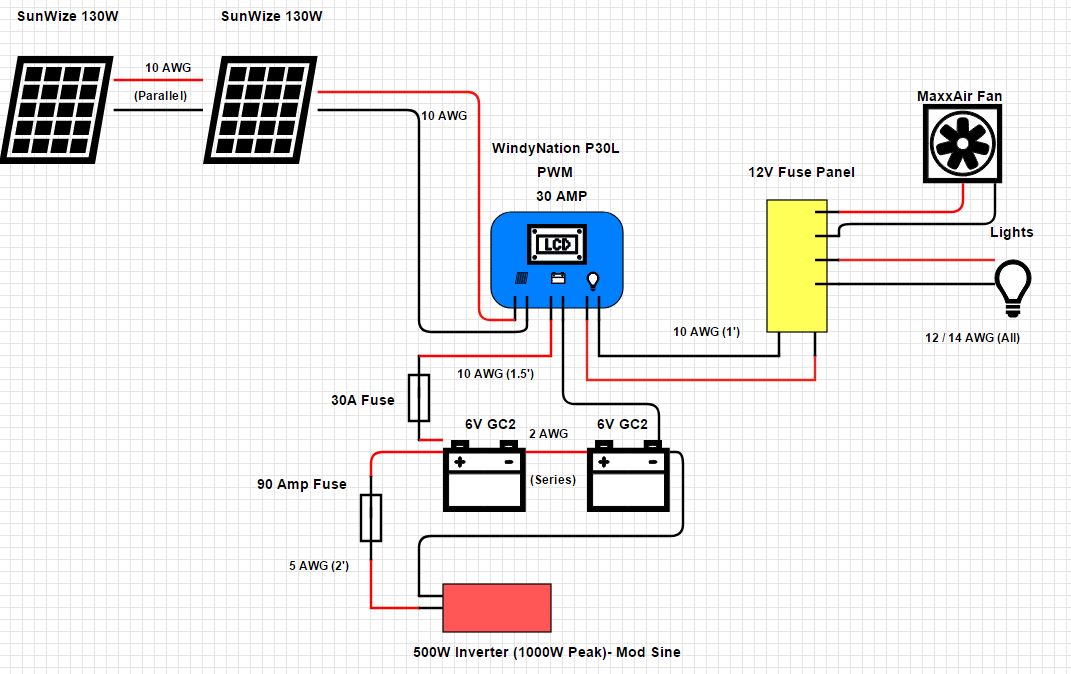pkb4112
New member
- Joined
- Jun 1, 2017
- Messages
- 2
- Reaction score
- 0
Hi everyone,
I've just started dwelling full time in an Astro, and I need to work on my laptop a lot for my photography work so I invested in a solar setup for my van. It is set up exactly as shown below, and note the batteries are flooded lead acid rated at 215Ah:

Now, when I first hooked everything up about a week ago, I just assumed it was fine. The charge controller would read 13.7 volts on the batteries which is the float voltage parameter on the charge controller. If I ran the fan or lights, the voltage would drop a bit, seemed normal.
Now today, I realized very quickly that something is very wrong. Today the van was in full sun, and I was sitting in the Lowe's parking lot working on my laptop. It was low on charge, so I plugged it into the inverter. It worked for a few hours, and I kept working as normal. I moved spots to a nice dirt pullout up here in New Hampshire, and hung out for a while to do some more work. The charge controller still showed 13.7 volts. I plugged in the inverter to charge my laptop, and turned on the fan. Not 5 minutes later, the fan shuts off. I thought "That's weird". And when I looked over, the charge controller was reading 12.3 volts and had turned off to protect the battery from draining too low. So I turn off the inverter, and the battery voltage goes back up to 13.6/13.7 within 5 minutes. At this point I'm concerned, but it didn't stop there. I drive again to a new spot down the road, and just let the batteries charge as I drive. When I park, I hear this weird noise. The batteries are gurgling and when I put my ear near them I could hear intense bubbling. The charge controller still shows 13.7 volts, and says it is only drawing 1.1 A from the panels.
I unplugged the solar panels from the charge controller immediately, and after 20 minutes or so the bubbling settled down, and the battery voltage read 12.9 volts. One more time, I tried to turn on the inverter, and just like the last time, it drained the batteries from 12.9 to 12.3 within 5 minutes. I was holding a voltmeter onto the battery terminals literally watching the values drop second by second. As soon as I turned off the inverter, the voltage rebounded back up to 12.8.
Are the batteries toast? I bought them literally a month ago from Batteries plus Bulbs, I don't see how they could be bad already? I stored them properly, and the water level has been perfect since I bought them.
Can anyone help? I'm at a loss for what to do, but my budget is very limited and I don't think I can afford to replace the batteries if they're already dead.
I've just started dwelling full time in an Astro, and I need to work on my laptop a lot for my photography work so I invested in a solar setup for my van. It is set up exactly as shown below, and note the batteries are flooded lead acid rated at 215Ah:

Now, when I first hooked everything up about a week ago, I just assumed it was fine. The charge controller would read 13.7 volts on the batteries which is the float voltage parameter on the charge controller. If I ran the fan or lights, the voltage would drop a bit, seemed normal.
Now today, I realized very quickly that something is very wrong. Today the van was in full sun, and I was sitting in the Lowe's parking lot working on my laptop. It was low on charge, so I plugged it into the inverter. It worked for a few hours, and I kept working as normal. I moved spots to a nice dirt pullout up here in New Hampshire, and hung out for a while to do some more work. The charge controller still showed 13.7 volts. I plugged in the inverter to charge my laptop, and turned on the fan. Not 5 minutes later, the fan shuts off. I thought "That's weird". And when I looked over, the charge controller was reading 12.3 volts and had turned off to protect the battery from draining too low. So I turn off the inverter, and the battery voltage goes back up to 13.6/13.7 within 5 minutes. At this point I'm concerned, but it didn't stop there. I drive again to a new spot down the road, and just let the batteries charge as I drive. When I park, I hear this weird noise. The batteries are gurgling and when I put my ear near them I could hear intense bubbling. The charge controller still shows 13.7 volts, and says it is only drawing 1.1 A from the panels.
I unplugged the solar panels from the charge controller immediately, and after 20 minutes or so the bubbling settled down, and the battery voltage read 12.9 volts. One more time, I tried to turn on the inverter, and just like the last time, it drained the batteries from 12.9 to 12.3 within 5 minutes. I was holding a voltmeter onto the battery terminals literally watching the values drop second by second. As soon as I turned off the inverter, the voltage rebounded back up to 12.8.
Are the batteries toast? I bought them literally a month ago from Batteries plus Bulbs, I don't see how they could be bad already? I stored them properly, and the water level has been perfect since I bought them.
Can anyone help? I'm at a loss for what to do, but my budget is very limited and I don't think I can afford to replace the batteries if they're already dead.





